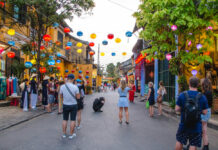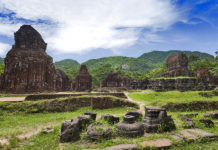There are compelling reasons to visit Vietnam, a country that seamlessly blends ancient traditions with modern vibrancy, offering travelers an unforgettable journey through its diverse landscapes, rich history, and warm hospitality. From exploring bustling cities and serene natural wonders to savoring exquisite cuisine and engaging in thrilling adventures, the reasons to visit Vietnam extend far beyond the ordinary, making it a must-see destination for anyone seeking cultural depth, natural beauty, and personal growth.
Rich Cultural Heritage and History
Vietnam’s cultural heritage and history form the backbone of what makes this nation so captivating, drawing travelers into a world where ancient legacies intertwine with resilient spirits. This section delves into the elements that showcase Vietnam’s enduring past, from sacred sites to vibrant traditions, illustrating why understanding this heritage is one of the top reasons to visit Vietnam. Exploring these aspects not only enriches your travel experience but also provides profound insights into the country’s soul.
Ancient Temples and Religious Sites
Exploring Vietnam’s ancient temples and religious sites reveals centuries of spiritual devotion that have shaped the country’s identity. These tranquil sanctuaries act as living museums where history and faith intersect, showcasing a rich mix of Buddhism, Confucianism, and local animism. The fragrant incense and ancient chants create a timeless atmosphere while highlighting ongoing cultural practices.
The stunning architectural details, such as intricate carvings on stone pillars and roofs depicting myths and legends, cannot be overlooked. Temples like the Perfume Pagoda in Hanoi attract millions yearly, nurturing a sense of community. The journey often includes scenic boat rides or hikes, enhancing the experience. This immersion allows travelers to see how religion impacts Vietnamese life, from daily customs to national celebrations, emphasizing Vietnam’s spiritual richness.
Engaging with monks or local worshippers provides insight into personal faith stories. Many sites have survived wars and colonialism, symbolizing the resilience of the Vietnamese spirit. The Tran Dynasty temples, for example, display artifacts that reflect resistance against invaders, blending history with spirituality. This connection encourages reflection on perseverance and cultural preservation, making visits transformative experiences that increase Vietnam’s appeal as a destination.
UNESCO World Heritage Sites
The UNESCO World Heritage Sites in Vietnam are significant markers of the nation’s history, showcasing its imperial and colonial past. These carefully preserved locations narrate Vietnam’s development, where each artifact reflects cultural exchanges and human creativity. Visiting these sites is essential for history buffs to grasp the country’s rich historical backdrop.
For instance, the Complex of Hue Monuments includes royal palaces, tombs, and pagodas from the Nguyen Dynasty. As visitors stroll through, they can envision the grandeur of the royal courts, with elaborate gates and beautiful gardens exemplifying 19th-century Vietnamese architecture. Designated as a UNESCO site in 1993, it holds global significance, safeguarding it from modern threats while ensuring that future generations can appreciate this historical gem. This dedication to preservation underscores Vietnam’s respect for its heritage, making visits both educational and emotionally fulfilling.
Additionally, places like the Citadel of the Ho Dynasty provide glimpses into ancient governance and military strategies, featuring stone walls that have lasted over six centuries. Exploring these historic fortifications, especially under ancient banyan trees, inspires awe at the engineering marvels achieved without contemporary tools. These sites also host cultural events, where traditional performances animate history, creating a connection between the past and today. Such engaging experiences are key motivations for visiting Vietnam, merging personal exploration with shared memories.
Ultimately, these UNESCO sites foster a comprehensive understanding of Vietnam’s history by blending archaeological discoveries with local legends. Travelers can join guided tours that explain the meaning behind artifacts, such as the detailed designs on ancient ceramics at the My Son Sanctuary. This enhances knowledge while supporting sustainable tourism, as visitor fees contribute to preservation efforts. Engaging with these sites reveals the complex layers of Vietnamese culture, reinforcing the reasons to visit Vietnam as a journey of discovery.
Traditional Festivals and Celebrations
Vietnam’s traditional festivals are lively celebrations of community and history, turning everyday moments into captivating events. Rooted in agriculture and ancestor worship, these occasions showcase the rich social tapestry of Vietnam through music, cuisine, and rituals. They offer travelers a genuine cultural experience, making Vietnam a top destination for those seeking vibrant interactions.
During Tet Nguyen Dan, the Lunar New Year, streets burst with colors as dragon dances and fireworks symbolize renewal and family gatherings. This week-long festival includes preparing traditional dishes and cleaning homes to invite good luck, highlighting beliefs in prosperity. Visitors can engage by receiving red envelopes or sharing meals with locals, fostering connection and respect.
The Mid-Autumn Festival is another highlight, with lanterns lighting up the night as children don colorful masks and tell folk tales. Celebrating harvest traditions, the event features mooncakes with symbolic fillings like lotus seeds, representing unity. Storytelling sessions at community centers preserve oral histories, emphasizing the role of festivals in strengthening cultural identity amidst globalization.
These celebrations deeply connect generations, exemplified by Hung Kings’ Commemoration Day, where many visit ancestral temples to honor Vietnam’s founders. This ritual, involving sticky rice and incense offerings, evokes national pride and continuity. For travelers, these experiences provide insights into resilience and community, making them vital for understanding Vietnam’s cultural essence.
Unique Customs and Local Traditions
The distinct customs and traditions of Vietnam vividly illustrate daily life, showcasing a society influenced by its historical context. From the ways of greeting to food rituals, these practices emphasize values such as respect and community, making Vietnam an enticing destination for visitors. Travelers can fully engage with these cultural experiences, fostering deep connections.
In rural regions, the common greeting “xin chao” leads to tea ceremonies where green tea represents hospitality and equality. These gatherings often involve light conversation, highlighting the significance of relationships in Vietnamese culture. Guests may be invited to take part, gaining insights into patience and mindfulness that stem from agricultural traditions.
Another key tradition is ancestor worship, which involves family altars adorned with photographs and offerings made to honor those who have passed away. This practice, rooted in Confucian beliefs, demonstrates a perspective where the past influences the present. During important occasions like the Ghost Festival, travelers might observe ceremonies that pay tribute to spirits, serving as reminders of mortality and legacy.
Social customs, such as removing shoes before entering homes, illustrate values of humility and cleanliness. Tourists who embrace these traditions demonstrate respect, enhancing their interactions with locals and transforming their visits into cultural exchanges that expand their horizons and create lasting memories.
Stunning Natural Landscapes
Vietnam’s stunning natural landscapes captivate with their sheer diversity and beauty, inviting adventurers and nature lovers to explore untouched wilderness and dramatic vistas. This section uncovers the reasons to visit Vietnam through its mountains, beaches, and ecosystems, where every horizon tells a story of geological wonder and ecological richness. Before diving into specifics, it’s essential to note that these landscapes not only offer visual splendor but also opportunities for reflection and rejuvenation.
Breathtaking Mountain Ranges and Valleys
The mountain ranges and valleys of Vietnam present breathtaking vistas that define the country’s rugged terrain, drawing hikers and photographers to their majestic peaks and verdant slopes. These areas, such as the famed Ha Giang Loop, feature limestone karsts and terraced rice fields that cascade like emerald stairs, creating a visual symphony of nature’s artistry. Exploring them reveals the intricate balance between human habitation and the environment, a key reason to visit Vietnam for those seeking awe-inspiring scenery.
Amid these mountains, trails wind through mist-shrouded passes, where the air is filled with the scent of pine and wildflowers, offering a serene escape from urban life. For instance, the Fansipan peak in the Hoang Lien Son range, often called the “Roof of Indochina,” challenges climbers with its steep ascents and rewarding summits, where panoramic views stretch endlessly. This physical engagement with the landscape fosters a sense of accomplishment, as travelers navigate paths used by ethnic minorities for centuries, learning about sustainable farming practices along the way.
Beyond the visuals, these regions harbor unique biodiversity, with rare species like the golden langur inhabiting the dense forests of the Annamite Range. Venturing into valleys like those in Sapa, visitors can witness the interplay of seasons, from foggy winters to vibrant spring blooms, each transforming the scenery. This dynamic environment not only highlights ecological importance but also underscores the reasons to visit Vietnam for immersive nature experiences that promote conservation awareness.
In essence, the mountains and valleys serve as a canvas for cultural narratives, where ethnic groups like the Hmong maintain traditional lifestyles in harmony with the land. Interactions with these communities, through homestays or guided treks, provide insights into age-old customs, making the journey multifaceted. Thus, these landscapes embody the reasons to visit Vietnam, blending adventure, beauty, and cultural depth into an unforgettable exploration.
Pristine Beaches and Coastal Areas
Vietnam’s pristine beaches and coastal areas offer idyllic retreats where golden sands meet turquoise waters, providing a perfect blend of relaxation and discovery. These shores, from the bustling strips of Nha Trang to the secluded bays of Phu Quoc, exemplify the country’s coastal charm, attracting sun-seekers and water enthusiasts. The allure lies in their accessibility and variety, making them compelling reasons to visit Vietnam for coastal getaways.
Strolling along beaches like those in Da Nang, one encounters soft sands fringed by palm trees, with the gentle lapping of waves creating a soothing backdrop. The water is crystal clear, ideal for snorkeling among vibrant coral reefs, where marine life thrives in protected areas. This natural splendor is enhanced by local fishing villages, where communities practice traditional methods, offering visitors a chance to sample fresh seafood straight from the sea, bridging leisure with cultural immersion.
The coastal regions also feature dramatic landscapes, such as the Hai Van Pass, where mountains plunge into the ocean, creating spectacular viewpoints. Here, the interplay of land and sea fosters biodiversity, with mangrove forests serving as vital habitats. Engaging in activities like kayaking through these ecosystems educates travelers on environmental conservation, highlighting the reasons to visit Vietnam as a way to appreciate and protect natural wonders.
Ultimately, these beaches provide a sanctuary for reflection, where the rhythm of the tides mirrors life’s ebb and flow. Whether lounging on Mui Ne’s dunes or exploring hidden coves, the experience reinforces the reasons to visit Vietnam, offering a harmonious mix of tranquility and adventure that rejuvenates the spirit.
Lush Terrestrial and Marine Ecosystems
The lush terrestrial and marine ecosystems of Vietnam burst with life, showcasing a biodiversity that rivals some of the world’s most celebrated regions. From dense rainforests to vibrant coral reefs, these areas represent the pinnacle of natural abundance, providing endless opportunities for exploration. This richness not only sustains wildlife but also supports human communities, making it a fundamental reason to visit Vietnam for eco-conscious travelers.
In the terrestrial realm, places like Cat Tien National Park host a variety of flora and fauna, including endangered species like the Javan rhinoceros. The forest floors are carpeted with ferns and orchids, while canopies teem with birds and monkeys, creating a symphony of sounds that immerses visitors in the wild. Trekking through these paths reveals the delicate balance of ecosystems, where every plant and animal plays a role, educating travelers on the importance of preservation.
Marine ecosystems, particularly in the Con Dao Islands, feature underwater worlds alive with colorful fish and sea turtles, drawing divers to their depths. The clear waters allow for up-close encounters, highlighting the threats of pollution and overfishing. This awareness fosters a deeper appreciation, as visitors learn about conservation projects that involve local fishermen, demonstrating sustainable practices.
These ecosystems underscore the reasons to visit Vietnam by offering a glimpse into the planet’s interconnectedness, where protecting one area benefits the whole. Engaging with guided tours, travelers can contribute to eco-initiatives, turning their visits into meaningful contributions to global efforts.
Impressive Waterfalls and Caves
Vietnam’s impressive waterfalls and caves form dramatic natural spectacles that captivate with their power and mystery. Sites like Ban Gioc Falls and Hang Son Doong present geological wonders that have been sculpted over millennia, inviting adventurers to delve into their secrets. This exploration reveals the raw beauty of nature, a key reason to visit Vietnam for thrill-seekers and geologists alike.
Waterfalls such as those in Dalat cascade down mossy cliffs, creating rainbows in the mist and pools for swimming, blending aesthetics with recreation. The surrounding jungles add to the allure, with trails leading to hidden spots that feel like discoveries from another era.
Caves like Phong Nha offer vast chambers with stalactites and underground rivers, where guided tours illuminate ancient formations. This subterranean world fosters a sense of wonder, connecting visitors to Earth’s history.
Together, these features highlight the reasons to visit Vietnam, providing adventures that inspire awe and respect for nature’s forces.
Delicious and Diverse Cuisine
Vietnam’s delicious and diverse cuisine is a gastronomic adventure that tantalizes the palate with flavors shaped by history and geography. This section explores the reasons to visit Vietnam through its food, where every meal tells a story of cultural fusion. Before the subheadings, it’s worth noting that Vietnamese cuisine emphasizes fresh ingredients and balance, making it not just food, but a holistic experience.
Iconic Vietnamese Dishes
Iconic Vietnamese dishes like pho and spring rolls represent a culinary heritage that blends simplicity with depth, drawing foodies from around the world. Pho, with its aromatic broth and tender meats, is more than a soup—it’s a comforting ritual that varies by region. Preparing it involves hours of simmering spices, reflecting the patience embedded in Vietnamese culture.
Each bowl offers a canvas for personalization, with herbs and condimentsthat allow diners to create their perfect flavor profile. This communal aspect of dining transforms a simple meal into a social event, embodying the Vietnamese spirit of hospitality. From street vendors to high-end restaurants, the experience of savoring pho becomes a cultural immersion that underscores the reasons to visit Vietnam.
Banh mi, another iconic dish, showcases the fusion of French colonial influences with local ingredients. The crispy baguette, filled with savory meats, pickled vegetables, and fresh herbs, is a handheld delight that symbolizes the intersection of cultures. Exploring local markets where these sandwiches are crafted provides insight into daily life and culinary traditions, making it an essential part of one’s journey through Vietnam.
Moreover, regional specialties like cao lau from Hoi An or bun cha from Hanoi highlight the diversity within Vietnamese cuisine. Each dish reflects the local landscape and climate, utilizing available resources to create unique flavors. Embracing these variations allows travelers to appreciate the rich tapestry of the nation’s culinary identity, reinforcing the reasons to visit Vietnam as a gastronomic epicenter.
Street Food Culture
Vietnam’s street food culture is a vibrant facet of everyday life, offering an authentic taste of local traditions and flavors right at the doorstep. This phenomenon extends beyond mere nourishment; it’s a communal experience steeped in history and craftsmanship. Wandering through bustling streets lined with food stalls invites visitors to engage with the local culture, providing compelling reasons to visit Vietnam for an immersive culinary adventure.
Street food vendors often serve time-honored recipes passed down through generations. Engaging with these artisans reveals not only the story behind each dish but also the passion and dedication they pour into their craft. Whether it’s watching a vendor skillfully wrap banh xeo (Vietnamese pancakes) or steaming fresh dumplings, this interaction enriches the travel experience, allowing for personal connections with the people who make up the fabric of Vietnamese society.
Furthermore, the affordability of street food makes it accessible for all travelers, creating opportunities to sample various dishes without breaking the bank. With an array of options available, from savory bun rieu (crab noodle soup) to sweet che (dessert soups), there’s something to tantalize every palate. These casual dining experiences encourage adventurous eating and foster a sense of exploration, further establishing the reasons to visit Vietnam as a culinary playground.
Lastly, enjoying street food often takes place in lively settings, where locals gather, laughter fills the air, and conversations flow freely. This atmosphere can be contagious, drawing travelers into the heart of community life. Savoring a warm bowl of pho on a bustling sidewalk, surrounded by the sounds and sights of the city, creates lasting memories tied to the essence of Vietnam.
Fresh Seafood and Local Specialties
The coastal geography of Vietnam positions it uniquely as a haven for fresh seafood and local specialties, making this another compelling reason to visit. With thousands of kilometers of coastline, fishing remains a vital industry that affects both the economy and the culinary scene. Travelers seeking authentic experiences will find that the freshest catches often grace the menus of coastal restaurants and beachfront shacks alike.
Regions such as Ha Long Bay are renowned for their delectable seafood offerings. Lobsters, prawns, squid, and a plethora of fish are prepared using traditional techniques that enhance the natural flavors. Dining on a floating restaurant while surrounded by stunning limestone karsts epitomizes the charm of Vietnamese seafood cuisine, combining breathtaking views with culinary delight. Sampling dishes that showcase the rich bounty of the sea not only satisfies the palate but also deepens appreciation for the maritime culture that defines many Vietnamese communities.
Moreover, local specialties vary dramatically across different regions, presenting ample opportunity for culinary exploration. In the south, dishes like grilled fish wrapped in banana leaves offer tropical flavors that echo the lush landscapes. In contrast, northern specialties feature more aromatic spices, emphasizing the use of fresh herbs that give each dish its distinctive character. This diversity encourages travelers to venture beyond the typical tourist fare, exploring local markets and eateries that reveal the heart of Vietnam’s culinary heritage.
Ultimately, indulging in fresh seafood and local specialties transcends mere gastronomy; it connects travelers to the land and its people. Understanding the relationship between the ocean, the environment, and culinary practices highlights the importance of sustainability and conservation efforts—further strengthening the reasons to visit Vietnam for those interested in responsible tourism.
Vibrant Cities and Urban Life
Vietnam’s vibrant cities pulse with energy and life, presenting a captivating juxtaposition of historical significance and modern development. Within these urban centers, visitors encounter a dynamic blend of cultures, traditions, and contemporary lifestyles, solidifying the reasons to visit Vietnam as a destination rich in urban exploration.
Hanoi’s Old Quarter and Colonial Architecture
Hanoi’s Old Quarter is a labyrinth of narrow streets and ancient buildings, each telling tales of centuries past. As you navigate through this district, the architecture reflects a confluence of Vietnamese and French styles, showcasing colonial-era facades alongside traditional Vietnamese shop houses. The intricate details in wrought iron balconies and decorative tiles speak volumes of the city’s colonial history, inviting exploration and admiration.
Strolling through the Old Quarter, one can appreciate the rhythmic dance of daily life: street vendors hawking their wares, craftsmen diligently working on their trades, and locals engaging in spirited conversations over cups of robust Vietnamese coffee. The sensory overload—the aroma of sizzling street food, the clatter of motorbikes weaving through traffic—is an integral part of the Hanoi experience, creating an atmosphere that envelops visitors.
This area is also home to historic landmarks, including Hoan Kiem Lake and Ngoc Son Temple, which offer peaceful retreats amidst the urban hustle. These sites provide insight into the spiritual and cultural fabric of the city, enriching one’s understanding of Vietnam’s history and identity. Engaging with local artisans and participating in cultural events further enhances the experience, revealing the layers of community life that thrive within this vibrant enclave.
Ho Chi Minh City’s Modern Vibrancy
In stark contrast to Hanoi, Ho Chi Minh City bursts with modernity and ambition, standing as the economic powerhouse of Vietnam. Skyscrapers pierce the skyline, housing international corporations and trendy boutiques, while the bustling streets are alive with the hum of scooters and commerce. Here, the energy is palpable, making it an exciting destination for travelers seeking a taste of contemporary Vietnamese urban life.
District 1 serves as the city’s beating heart, featuring glitzy shopping centers, fine dining establishments, and a vibrant nightlife scene. Visitors can explore the famous Ben Thanh Market, where a kaleidoscope of colors and sounds creates an exhilarating shopping experience. The market is not just a commercial hub; it embodies the spirit of entrepreneurship that drives the city forward.
As the sun sets, the city transforms into a playground for night owls. Rooftop bars and clubs come alive, offering sweeping views of the illuminated skyline. This nightlife culture further emphasizes the dynamic nature of Ho Chi Minh City, providing opportunities for socializing and connecting with fellow travelers and locals alike. The sheer vibrancy of the city reinforces the reasons to visit Vietnam as a country that seamlessly marries tradition with modernity.
Unique Markets and Shopping Districts
The unique markets and shopping districts throughout Vietnam present an exciting tapestry of commerce, culture, and connection. These bustling hubs provide a glimpse into the daily lives of locals while offering travelers the chance to immerse themselves in a variety of goods—from handcrafted souvenirs to vibrant textiles and delicious local snacks. Visiting these markets is undoubtedly one of the compelling reasons to visit Vietnam.
Markets like the ones in Hoi An or Da Nang stand out for their artisanal offerings. As you wander through vibrant stalls, the artistry in handmade crafts, intricate embroidery, and local pottery comes alive. Engaging with artisans and learning about their techniques fosters a deeper connection to the culture and encourages sustainable shopping practices that support local economies.
In addition to handicrafts, food markets serve as a paradise for culinary enthusiasts. Sampling local delicacies and seasonal fruits opens a window into the region’s agricultural bounty, while informal cooking classes held on-site provide hands-on experiences that deepen one’s appreciation for Vietnamese cuisine. These marketplaces demonstrate the community spirit that thrives in Vietnam, making them vital stops on any travel itinerary.
Ultimately, the unique markets and shopping districts reflect the soul of Vietnam, presenting opportunities to build connections and discover the authentic heartbeat of the country. Those who take the time to explore these vibrant spaces leave with not only tangible souvenirs but also cherished memories of cultural exchanges.
Nightlife and Entertainment Options
Vietnam’s nightlife offers an eclectic range of entertainment options that cater to diverse interests, ensuring that evenings are filled with excitement and engagement. From sophisticated rooftop bars in Ho Chi Minh City to traditional music performances in Hanoi, the nightlife scene is reflective of the country’s dynamic cultural landscape, serving as yet another reason to visit Vietnam.
In Hanoi, visitors can experience the enchanting sounds of traditional forms of music at venues like the Thang Long Water Puppet Theatre. This unique art form dates back centuries and tells stories of Vietnamese folklore through puppetry on water, captivating audiences with its creativity and cultural significance. Such performances provide a deeper understanding of the nation’s artistic heritage, enriching the overall travel experience.
Conversely, Ho Chi Minh City’s nightlife leans towards the contemporary, with a plethora of bars, clubs, and live music venues pulsating with energy. Areas like Bui Vien Street become vibrant hotspots after dark, where locals and tourists mingle over drinks, enjoying live bands and DJs spinning tunes late into the night. This lively atmosphere fosters social interactions that celebrate the spirit of togetherness, strengthening the reasons to visit Vietnam for those eager to connect with others.
Additionally, themed nights—ranging from karaoke to cooking classes—offer alternative ways to engage with local culture while having fun. These interactive experiences allow travelers to step outside their comfort zones, immersing themselves in the jovial spirit of Vietnamese nightlife. Ultimately, the myriad options available ensure that no two evenings in Vietnam are ever the same.
Affordable Travel Destination
One of the most enticing aspects of traveling to Vietnam is its affordability, which allows visitors to experience a wealth of adventures without stretching their budgets. This cost-effectiveness presents a compelling reason to visit for backpackers, families, and luxury travelers alike, providing opportunities for a wide range of experiences at reasonable prices.
Budget-Friendly Accommodation Options
Vietnam boasts an extensive array of budget-friendly accommodation options, catering to all types of travelers. Hostels, guesthouses, and homestays offer comfortable stays at a fraction of the price compared to other destinations in Southeast Asia. A night in cozy dormitory-style lodgings or a charming local guesthouse can provide not only a place to rest but also insightful cultural exchanges with hosts eager to share their stories and recommendations.
Many accommodations are strategically located near popular attractions, allowing travelers to explore cities conveniently without additional transportation costs. Staying in areas like the Old Quarter in Hanoi or the backpacker district in Ho Chi Minh City can immerse visitors in local life while providing easy access to culinary delights and cultural experiences.
Additionally, mid-range hotels and boutique accommodations offer luxurious touches without breaking the bank. Travelers can indulge in amenities such as swimming pools, spa services, and delightful breakfasts, enhancing their overall experience. The variety of choices ensures that anyone can find suitable lodging within their budget, making Vietnam a practical option for all.
Cost-Effective Transportation
Navigating Vietnam is made easy and affordable thanks to various transportation options available throughout the country. Public buses, trains, and domestic flights provide effective means to traverse the vast landscapes, each offering unique experiences along the way. This accessibility adds to the many reasons to visit Vietnam, allowing travelers to explore diverse regions without straining their wallets.
For budget-conscious travelers, local buses present a low-cost option for intercity travel. Not only do they help save money, but they also offer glimpses into everyday life as locals embark on their journeys. For longer distances, sleeper trains provide a comfortable and scenic alternative, allowing travelers to relax while marveling at the changing scenery.
Additionally, rideshare apps and local taxis make urban travel convenient and inexpensive. Motorbike rentals are also popular, granting adventurous souls the freedom to explore off-the-beaten-path destinations. Embracing these economical modes of transport fosters a sense of independence and discovery that aligns perfectly with the travel ethos of Vietnam.
Inexpensive Local Dining Choices
Dining in Vietnam is a delightful affair, with countless inexpensive local dining choices that allow travelers to savor authentic flavors and experiences. Street food stalls, small eateries, and local markets present countless opportunities to enjoy delicious meals without the hefty price tag typical of many tourist-oriented restaurants.
Local dishes often range from just a few dollars to even less, making it possible to sample a wide variety of culinary delights throughout one’s stay. Indulging in street food favorites like banh mi or pho not only pleases the palate but also supports local vendors, fostering community relationships that resonate well with culturally conscious travelers.
Moreover, dining family-style in local restaurants encourages sharing and bonding over meals, highlighting the importance of community in Vietnamese culture. Gathering around a large table laden with diverse dishes creates a convivial atmosphere that nurtures connections among diners. These memorable culinary experiences enhance the trip, reinforcing the reasons to visit Vietnam as more than just a vacation but a journey into the heart of a vibrant culture.
Adventure and Outdoor Activities
Vietnam’s diverse landscapes provide a treasure trove of adventure and outdoor activities that entice thrill-seekers and nature lovers alike. From the rugged peaks of the north to the serene beaches of the south, the opportunities for exploration and excitement are nearly limitless. This multifaceted approach to adventure stands as a significant reason to visit Vietnam, inviting travelers to immerse themselves in the great outdoors.
Trekking and Hiking Trails
Trekking and hiking trails weave through some of the most breathtaking landscapes in Vietnam, offering encounters with the country’s natural beauty and vibrant cultures. Regions like Sapa draw adventurers with their dramatic terraced rice fields and mountainous terrain, where picturesque villages await exploration. Guided treks provide insights into the lives of ethnic minority groups, showcasing traditional customs and agricultural practices that have persisted for generations.
The experience of trekking through these lush landscapes encourages a deeper connection to the environment and promotes physical wellness. As you navigate winding paths while surrounded by towering mountains, the serenity of nature fosters moments of reflection and gratitude. Rushing rivers and cascading waterfalls punctuate the journey, reminding travelers of the raw power and beauty of the natural world.
Beyond Sapa, other regions like Phong Nha-Ke Bang National Park offer stunning trails leading to remarkable caves and karst formations. Hiking through these areas showcases the geological wonders of Vietnam, enriching the adventure with educational experiences that highlight the country’s ecological significance. Ultimately, the combination of physical activity and breathtaking scenery reinforces the reasons to visit Vietnam as a destination for outdoor enthusiasts.
Water Sports and Diving Spots
Vietnam’s extensive coastline provides an ideal backdrop for water sports and diving adventures that captivate both beginners and seasoned enthusiasts. Destinations such as Nha Trang or Phu Quoc Island are adorned with crystal-clear waters and vibrant coral reefs, inviting exploration beneath the surface. Engaging with the underwater ecosystem allows travelers to forge connections with marine life while appreciating the delicate balance of oceanic environments.
Scuba diving and snorkeling excursions bring participants face-to-face with colorful fish, fascinating corals, and sometimes even majestic turtles. Many tour operators offer guided trips to prime locations, ensuring safety while enriching the experience with valuable insights about marine ecology. This engagement with aquatic life fosters awareness of conservation issues, encouraging travelers to advocate for the protection of fragile ecosystems.
Additionally, kayaking and paddleboarding provide alternative ways to explore pristine lagoons and mangrove forests. Gliding silently through serene waters allows travelers to observe wildlife and immerse themselves in the tranquility of Vietnam’s coastal landscapes. These adventures create unforgettable memories while reinforcing the compelling reasons to visit Vietnam for exhilarating experiences in nature.
Cycling Tours and Eco-Travel
Cycling tours present an eco-friendly way to explore Vietnam’s diverse terrains while connecting with local communities and cultures. Riding through quaint towns and villages allows travelers to witness the daily rhythms of life in Vietnam, from farmers tending to rice paddies to children playing in the streets. This grassroots approach to travel fosters meaningful interactions that deepen appreciation for the country’s rich heritage.
Various cycling routes cater to different skill levels, ranging from leisurely rides through the countryside to challenging mountain routes. Tour operators often include itineraries that incorporate visits to historical sites, markets, and artisan workshops, offering a holistic view of the local lifestyle. Participating in these tours highlights the commitment to sustainable tourism practices, supporting local economies while minimizing environmental impact.
Additionally, eco-travel initiatives emphasize responsible tourism, encouraging visitors to prioritize conservation and cultural sensitivity. Engaging with projects aimed at preserving natural resources and supporting local livelihoods fosters a sense of responsibility and respect for the land. Ultimately, cycling tours represent a harmonious blend of adventure and ethics, reinforcing the reasons to visit Vietnam for those passionate about sustainable exploration.
Exploration of Remote Villages
Exploring remote villages in Vietnam provides an authentic glimpse into traditional lifestyles and age-old customs. Traveling to places off the beaten path allows visitors to engage with indigenous communities, enriching their understanding of the country’s cultural heritage. This immersion into daily life serves as a compelling reason to visit Vietnam for those seeking unique experiences.
Villages nestled in the mountains, such as those in the Mu Cang Chai region, showcase the stunning craftsmanship of local artisans, whose skills have been honed over generations. Engaging with these communities allows travelers to witness cultural practices firsthand, whether it’s textile weaving, farming, or culinary traditions. Participating in workshops and festivals fosters connections that transcend language barriers, highlighting the universal nature of human experience.
Moreover, spending time in remote villages immerses visitors in striking landscapes where pristine nature reigns supreme. Trekking through unspoiled valleys and interacting with locals amid breathtaking vistas creates a powerful sense of belonging and gratitude. These encounters transform a typical trip into a transformative journey rooted in cultural exchange and personal growth, underscoring the compelling reasons to visit Vietnam.
Unique Arts and Crafts
Vietnam’s rich tradition of arts and crafts reflects a creative heritage that spans centuries, merging functionality with artistic expression. From intricate textiles to delicate ceramics, the country’s varied artistic practices provide travelers with insights into the cultural landscape. This vibrant arts scene serves as an additional reason to visit Vietnam, inspiring curiosity and appreciation for local craftsmanship.
Traditional Handicrafts and Textiles
Traditional handicrafts and textiles embody the essence of Vietnam’s cultural identity, with artisanal practices passed down through generations. Regions like Hoi An and Bat Trang are renowned for their craft industries, where skilled artisans create beautiful products that tell stories of their heritage. Visitors are drawn to the meticulous processes involved in weaving silk, embroidering patterns, and creating pottery, which elevate these items beyond mere commodities.
Participating in workshops allows travelers to engage directly with artisans, fostering connections that deepen understanding of the cultural significance behind each piece. Learning to weave intricate designs or mold clay transforms the experience from passive observation to active participation, creating lasting memories tied to the hands that shape Vietnam’s artistic legacy.
Moreover, purchasing handmade crafts supports local economies and sustains traditional practices. Choosing unique pieces over mass-produced souvenirs fosters a sense of responsibility toward preserving cultural heritage, reinforcing the reasons to visit Vietnam as a destination that values authentic craftsmanship.
Contemporary Art Scene
The contemporary art scene in Vietnam offers a dynamic perspective on the country’s evolving identity, blending tradition with innovation. Galleries and art collectives across cities like Hanoi and Ho Chi Minh City showcase the works of emerging artists who challenge conventions and address social issues through their creative expressions. Exploring this burgeoning landscape provides insight into the current zeitgeist of Vietnamese culture, making it an intriguing reason to visit.
Art events, exhibitions, and festivals create opportunities for travelers to engage with artists and their work, fostering conversations that illuminate the interplay between historical context and modernity. By witnessing how contemporary artists reinterpret traditional themes, visitors gain a nuanced understanding of the societal shifts occurring within Vietnam.
Additionally, urban street art has flourished in recent years, transforming public spaces into open galleries. Walking through the streets adorned with vibrant murals invites exploration of themes ranging from politics to personal narratives, reflecting the voices of the community. This intersection of art and activism highlights the role of creativity in shaping cultural discourse, reinforcing the reasons to visit Vietnam for an inspiring artistic adventure.
Artisan Markets and Souvenirs
Artisan markets and local souvenir shops throughout Vietnam provide a treasure trove of unique finds that celebrate the nation’s artistic diversity. These markets brim with locally made products, from textiles to jewelry, inviting travelers to take home pieces that carry stories and significance. Exploring these vibrant marketplaces becomes a delightful quest for memorable keepsakes, adding to the reasons to visit Vietnam.
Shopping in artisan markets often involves engaging directly with the creators, allowing for personal connections that enrich the experience. Understanding the labor and passion that goes into each piece deepens appreciation for the craftsmanship, making souvenirs not just decorative items but meaningful reminders of the journey undertaken.
Additionally, artisan markets frequently promote sustainable practices by prioritizing local materials and fair trade principles. Supporting these artisans contributes to preserving traditional skills and empowering communities, aligning beautifully with the values of responsible tourism. Ultimately, the experience of discovering unique arts and crafts in Vietnam resonates with travelers long after they return home.
Warm Hospitality and Friendly Locals
The warm hospitality and friendliness of the locals in Vietnam create an inviting atmosphere that enhances the travel experience. The genuine smiles and welcoming gestures of the Vietnamese people serve as a testament to their rich cultural values, making visitors feel embraced and appreciated. This warmth stands as a compelling reason to visit Vietnam for those seeking authentic human connections during their journeys.
Cultural Etiquette and Social Norms
Understanding cultural etiquette and social norms in Vietnam reveals the depth of respect embedded within everyday interactions. From greetings to dining customs, the nuances of social behavior highlight the significance of community and familial bonds in Vietnamese culture. Engaging with locals while being mindful of these customs fosters a respectful exchange that enriches the travel experience.
For instance, greetings often involve a nod or slight bow, demonstrating humility and recognition. Dining etiquette emphasizes communal sharing, where dishes are placed in the center and everyone partakes together. Observing these customs fosters goodwill and facilitates connections, allowing visitors to immerse themselves in the rhythm of daily life.
Moreover, learning a few Vietnamese phrases can significantly enhance interactions, as locals appreciate the effort to communicate in their native language. Simple words of gratitude or friendly greetings can bridge linguistic divides, opening doors to deeper conversations and connections. Embracing cultural etiquette empowers travelers to engage meaningfully with the local community, reinforcing the reasons to visit Vietnam as a destination that celebrates interpersonal relationships.
Engaging with Local Communities
Engaging with local communities in Vietnam creates opportunities for enriching experiences that go beyond typical tourist interactions. Travelers who take the time to participate in community activities or volunteer initiatives discover the vibrant tapestry of Vietnamese life firsthand. Such interactions underscore the importance of understanding and appreciating diverse cultures, adding depth to the reasons to visit Vietnam.
Joining workshops led by local artisans or participating in community-led projects allows visitors to contribute positively while learning valuable skills. Whether it’s helping with organic farming or assisting in cultural preservation efforts, these experiences foster mutual respect and understanding, creating lasting bonds between visitors and locals.
Moreover, homestays offer travelers a chance to experience life through the eyes of Vietnamese families. Sharing meals, learning traditional cooking methods, and participating in local festivals nurture friendships and create memorable moments. These genuine connections allow travelers to experience the heart of Vietnam, reinforcing the notion that travel is as much about human connections as it is about sightseeing.
Fascinating Marine and Land National Parks
Vietnam is endowed with several national parks that showcase the nation’s stunning biodiversity and ecological importance. These protected areas provide a sanctuary for wildlife and a playground for outdoor enthusiasts, making them yet another compelling reason to visit Vietnam. Exploring these parks not only fosters a connection with nature but also promotes conservation efforts that protect invaluable ecosystems.
Phong Nha-Ke Bang Cave System
Phong Nha-Ke Bang National Park is renowned for its extraordinary cave system, recognized as a UNESCO World Heritage Site. Home to some of the largest and most impressive caves globally, such as Son Doong, this park presents adventurers with unparalleled opportunities for exploration. Discovering this subterranean wonderland creates awe and admiration for nature’s artistic prowess.
Caving expeditions in Phong Nha involve navigating through colossal chambers adorned with stunning stalactites and stalagmites, often formed over millions of years. Guided tours provide valuable insights into the geological significance of these formations while ensuring visitor safety. Engaging with knowledgeable guides enhances the experience, as they share captivating stories about the park’s history and the delicate balance required to preserve its natural beauty.
In addition to caving, the surrounding landscapes offer stunning trekking routes, allowing travelers to experience the park’s diverse flora and fauna. Birdwatching, wildlife photography, and kayaking provide further avenues for exploration, showcasing the ecological richness that thrives within this protected area. Ultimately, Phong Nha-Ke Bang National Park stands as a testament to Vietnam’s natural wonders, reinforcing the reasons to visit for lovers of adventure and nature.
Ba Be Lake and Surrounding Forests
Ba Be Lake, situated in the heart of Ba Be National Park, captivates visitors with its serene beauty and tranquil surroundings. Renowned as the largest natural freshwater lake in Vietnam, it serves as a crucial habitat for various plant and animal species. Exploring this idyllic setting allows travelers to immerse themselves in the stunning landscapes, offering yet another reason to visit Vietnam for nature enthusiasts.
The lake is encircled by verdant forests and limestone mountains, providing a picturesque backdrop for activities such as boating, kayaking, and hiking. Travelers can engage with local ethnic communities who inhabit the region, gaining insights into their traditional lifestyles and customs. These interactions foster cultural exchanges that enrich the travel experience, revealing the interconnectedness of humanity and nature.
Additionally, guided tours often include visits to nearby waterfalls and caves, enhancing the exploration of the area. The pristine environment of Ba Be Lake emphasizes the importance of conservation, encouraging visitors to appreciate and protect this unique ecosystem. This experience exemplifies the harmony between adventure and environmental stewardship, reinforcing the reasons to visit Vietnam as a destination for responsible travel.
Unique Architectural Landmarks
Vietnam is home to a wealth of architectural landmarks that reflect the country’s rich history and cultural diversity. From ancient temples and pagodas to modern skyscrapers, the architectural landscape tells stories of Vietnam’s evolution through time. Exploring these unique structures not only offers aesthetic pleasure but also serves as a compelling reason to visit Vietnam for those interested in history and design.
Imperial Citadel of Hue
The Imperial Citadel of Hue stands as a testament to Vietnam’s imperial past, representing the grandeur of the Nguyen Dynasty. This UNESCO World Heritage Site is replete with intricately designed structures, moats, and gardens, inviting visitors to immerse themselves in the history of Vietnam’s former royal capital. The citadel’s architecture showcases a blend of Vietnamese and Chinese influences, offering a fascinating glimpse into the cultural interplay that shaped the region.
Walking through the expansive grounds, one can admire the attention to detail evident in the ornate gates, pavilions, and temples. Each corner of the citadel holds stories of emperors, scholars, and commoners, creating a rich tapestry of history that unfolds as visitors explore. Engaging with knowledgeable guides adds depth to the experience, as they share anecdotes and insights that breathe life into the architectural marvels.
Moreover, the citadel is surrounded by beautiful landscapes and the Perfume River, enhancing the overall aesthetic appeal. The sunset over the citadel creates a magical ambiance, as the warm hues bathe the ancient walls in golden light. This moment evokes a sense of connection to Vietnam’s storied past, reinforcing the reasons to visit as travelers appreciate the melding of history and beauty.
French Colonial Buildings in Hanoi and Ho Chi Minh City
The influence of French colonization is evident in the architectural styles found throughout Vietnam, particularly in major cities like Hanoi and Ho Chi Minh City. Stunning French colonial buildings, characterized by their elegant facades, wrought iron balconies, and spacious boulevards, evoke a sense of nostalgia and charm. Exploring these structures provides travelers with an understanding of the historical context that shaped modern Vietnam, making it an appealing reason to visit.
Iconic landmarks such as the Saigon Opera House and the Notre-Dame Cathedral Basilica of Saigon exemplify the grandeur of French architecture. Their intricate details and imposing presence offer photogenic backdrops for visitors seeking to capture the essence of the cities. Similarly, the French Quarter in Hanoi enchants with its picturesque streets lined with cafes and boutiques, evoking a European sensibility amidst Vietnamese culture.
Engaging with the architectural narrative of these cities fosters appreciation for the complexities of colonial history. It prompts reflections on cultural exchange, resilience, and adaptation, allowing travelers to grasp the dualities that define Vietnam’s identity today. This exploration of architectural landmarks ultimately reinforces the reasons to visit Vietnam as a destination imbued with history and character.
Conclusion
Ultimately, Vietnam invites travelers to embark on an unforgettable exploration, where adventure, beauty, and cultural depth coexist harmoniously. From the bustling streets to the serene countryside, the reasons to visit Vietnam continue to resonate deeply, beckoning explorers to discover the magic that lies within this remarkable country.






















